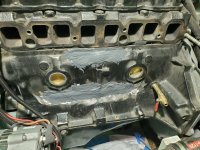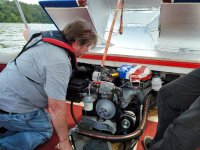Reserector_
Chief Petty Officer" & 2021 Splash of the Year Win
- Joined
- Oct 15, 2019
- Messages
- 650
Lately, I have been trying to "block seal" the small leaks in the outer water jacket of my 3.0L.
It was the engine that came with my restoration project, and had typical cracks from lack of winterizing by the person who gave me the boat.
I found the main cracks during the overhaul, and I brazed them. It wasn't until I had it in the boat that I discovered another small crack or two up higher, behind the manifold. I tried JB Weld, but it did not hold.
My braze repair has held. It is the upper crack that showed up later that I am fighting. It is a minor leak. I can run the boat for a couple hours before it gets high enough to pump anything out. I can keep running it like that until the engine market gets back to normal and I can afford a new one.

My understanding is that most sealers need warmth and pressure to push their sealing materials into the leak, where it will hopefully remain.
Understanding that my boat is not like a car in that it cannot continue to circulate the sealant after the thermostat opens, my hope is that it will be able to work BEFORE the thermostat opens so that I can either shut it down and repeat the circulation, or let it dump out onto the lawn.
A raw water system will not build pressure from heat, like a car. It builds BACKpressure between the impeller pump and the restrictor plate at the end of the exhaust where the water exits. If there were no pressure, there would be no leak.
I've also noted that the higher the RPMs, the greater the backpressure, because that is when it leaks the most.
I tried K-Seal Ultimate, and it worked, and then it didn't. Let me explain; I drained a good amount of water from the engine and then closed the drain. Then I poured the contents of the bottle into the large U-hose, which leads into the bottom of the block via the recirculating pump.
I started the engine and almost immediately ran it up to 2,300prm on muffs. I saw thin white streams dribbling down from the crack,,,then they sealed up. In seconds! I let it run like that until the thermostat was about to open, and shut the engine off.
After a complete cool-down, I started the engine and ran it up again. I saw the same amount of white streams again. Mind you, I can't see the crack because it is up behind the manifold. I assume the leaks were from the same places.
But again, they quickly stopped. I ran it up to around 3,200 and it was holding. I shut it down again and did the same routine one more time that evening. Same results.
The next evening, I got the same thing, so I just let it run after it sealed and let it stay at 175° for several minutes. But after a cool down and restart, the leaks were back, just plain water this time.
My next attempt will be the same plan, but with CRC's K&W Block Sealant. I'll let you know how it goes.
In the meantime, here is a picture of my pretty engine, my pretty self looking at said engine, and a photo of my restored '93 Caravelle 1750.


It was the engine that came with my restoration project, and had typical cracks from lack of winterizing by the person who gave me the boat.
I found the main cracks during the overhaul, and I brazed them. It wasn't until I had it in the boat that I discovered another small crack or two up higher, behind the manifold. I tried JB Weld, but it did not hold.
My braze repair has held. It is the upper crack that showed up later that I am fighting. It is a minor leak. I can run the boat for a couple hours before it gets high enough to pump anything out. I can keep running it like that until the engine market gets back to normal and I can afford a new one.

My understanding is that most sealers need warmth and pressure to push their sealing materials into the leak, where it will hopefully remain.
Understanding that my boat is not like a car in that it cannot continue to circulate the sealant after the thermostat opens, my hope is that it will be able to work BEFORE the thermostat opens so that I can either shut it down and repeat the circulation, or let it dump out onto the lawn.
A raw water system will not build pressure from heat, like a car. It builds BACKpressure between the impeller pump and the restrictor plate at the end of the exhaust where the water exits. If there were no pressure, there would be no leak.
I've also noted that the higher the RPMs, the greater the backpressure, because that is when it leaks the most.
I tried K-Seal Ultimate, and it worked, and then it didn't. Let me explain; I drained a good amount of water from the engine and then closed the drain. Then I poured the contents of the bottle into the large U-hose, which leads into the bottom of the block via the recirculating pump.
I started the engine and almost immediately ran it up to 2,300prm on muffs. I saw thin white streams dribbling down from the crack,,,then they sealed up. In seconds! I let it run like that until the thermostat was about to open, and shut the engine off.
After a complete cool-down, I started the engine and ran it up again. I saw the same amount of white streams again. Mind you, I can't see the crack because it is up behind the manifold. I assume the leaks were from the same places.
But again, they quickly stopped. I ran it up to around 3,200 and it was holding. I shut it down again and did the same routine one more time that evening. Same results.
The next evening, I got the same thing, so I just let it run after it sealed and let it stay at 175° for several minutes. But after a cool down and restart, the leaks were back, just plain water this time.
My next attempt will be the same plan, but with CRC's K&W Block Sealant. I'll let you know how it goes.
In the meantime, here is a picture of my pretty engine, my pretty self looking at said engine, and a photo of my restored '93 Caravelle 1750.


Last edited:




















